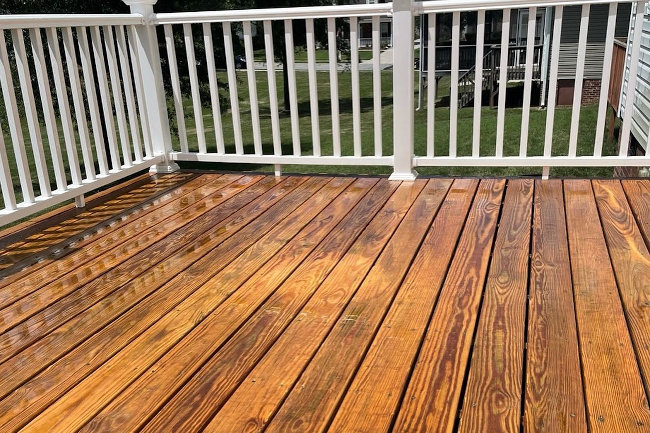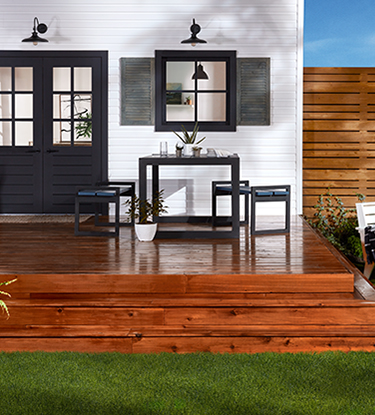Deck Staining Luster: Boost Your Exterior Living Room
Wiki Article
Choosing the Right Spot for Your Fence: Tips and Considerations
When it comes to enhancing the appearance and maintaining of your fence, selecting the ideal discolor is crucial. We will certainly explore the various types of fence stains, factors to take into consideration prior to picking a discolor, ideas for preparing your fencing for discoloration, and the distinctions between oil-based and water-based discolorations. Additionally, we will dive right into picking the appropriate tarnish shade to enhance your fencing and boost your outdoor room.Understanding Different Sorts Of Fence Stains

On the other hand, water-based spots are made from acrylic or latex and use a more refined color to the wood. They produce a safety movie externally of the timber, avoiding wetness from permeating in and protecting against UV damages. Water-based discolorations are simpler to clean up and have a much faster drying out time contrasted to oil-based stains. They are likewise much less most likely to split or discolor in time.
Choosing between oil-based and water-based stains depends on different variables, consisting of individual choice, the preferred look, and the degree of maintenance called for. Oil-based discolorations are advised for fencings in high-traffic locations or those continuously subjected to extreme climate condition. fence staining and sealing. Water-based discolorations, on the other hand, are a preferred selection for surround property locations where appearance and simplicity of use are necessary
When picking the ideal stain for their fencing,Understanding the distinctions between oil-based and water-based discolorations assists homeowners make an educated choice. Considering the certain requirements of the fencing, such as its place, exposure to sunshine, and wanted visual, will certainly make certain that the chosen stain supplies durable security and enhances the total charm of the fencing.
Factors to Think About Before Selecting a Stain

Different kinds of timber take in discolorations in a different way, resulting in differing degrees of shade strength and durability. Additionally, particular woods might be more susceptible to issues like rot or insect problem, which might influence the option of tarnish to protect and protect the fencing.
The climate and climate condition in your area ought to likewise be taken into consideration. If you live in an area with extreme winters or high humidity, you may need a stain that offers added security versus dampness and UV rays. Furthermore, if your fence is exposed to route sunshine for extended periods, a stain with UV preventions can aid protect against fading and staining.
Finally, it is necessary to consider your preferred aesthetic. Various discolorations use different colors and finishes, permitting you to tailor the look of your fencing (fence staining and sealing). Consider the total design and style of your property, in addition to any type of local laws or home owner organization guidelines that might dictate the acceptable tarnish colors
Tips for Readying Your Fence for Discoloration
Cleaning the fencing is a vital step as it gets rid of dust, gunk, and any kind of previous coverings that might interfere with the discoloration procedure. Scrub the surface delicately, paying additional focus to areas with persistent discolorations or mold.This action is vital as tarnishing a moist or damp surface can lead to bad attachment and an irregular coating. Ensure that the fence is completely dry prior to proceeding with the staining procedure.
Prior to discoloration, evaluate the fence for any kind of problems, such as loose boards or nails. This item aids to open up the wood pores, allowing the stain to penetrate extra properly and equally.

Comparing Water-Based and oil-based Stains
When choosing a tarnish for your fence, it is essential to contrast the attributes and benefits of water-based and oil-based discolorations. Both kinds of spots have their very own advantages and considerations, so it is vital to understand the distinctions between them.Oil-based spots are recognized for their resilience and resistance to use and tear. Furthermore, oil-based spots often tend to last longer than water-based discolorations, making them a popular choice for fences.
On the various other hand, water-based spots are much more environmentally pleasant and much easier to clean up. They might not offer the same degree of security as oil-based stains, specifically in severe weather conditions.
Ultimately, click for more the selection between water-based and oil-based stains relies on your specific needs and choices. Think about factors such as sturdiness, environmental impact, and convenience of application when making your decision. Consulting with a professional or looking for recommendations from professionals can additionally assist make sure that you choose the appropriate stain for your fencing.
Picking the Right Spot Shade for Your Fencing
The choice of an ideal discolor shade for your fencing is an important facet of boosting its visual allure and complementing the general layout of your outdoor area (fence staining). The ideal tarnish shade can transform a plain, common fencing into a striking focal point that includes deepness and character to your homeWhen selecting a stain shade for your fence, it is very important to consider the design and architecture of your home. Natural tones such as neutrals and browns can create a cozy and welcoming look if you have a classic or standard design home. On the other hand, if you have a contemporary or modern home, you might take into consideration selecting strong and vivid colors that make a declaration.
Another element to take into consideration is the natural environments of your residential or commercial property. If you have a whole lot of plant, a tarnish shade that enhances the natural landscape, such as environment-friendlies or crimsons, can create a cohesive and unified appearance.
In addition, it deserves considering the maintenance required for different stain colors. Lighter colors have a tendency to reveal dust and use even more quickly, while darker shades can conceal blemishes and require less frequent touch-ups.
Ultimately, the choice of stain color for your fence ought to reflect your personal style and preferences - fence staining and sealing. Put in the time to explore various alternatives and speak with with professionals if needed, to make sure that you pick the perfect discolor shade that improves the elegance and appeal of your fence
Final Thought
In final thought, when it involves choosing the right tarnish for your fence, it is very important to recognize the various kinds of stains available and think about aspects such as resilience and preferred appearance. Preparing the fence appropriately prior to discoloration is vital for attaining optimum outcomes. In addition, contrasting water-based and oil-based discolorations can aid determine the best option for your details demands. Selecting the right discolor color can improve the overall visual appeals of your fence.We will explore the various types of fencing spots, variables to think about prior to choosing a tarnish, ideas for preparing your fencing for discoloration, and the distinctions in between oil-based and water-based stains.Differentiating between oil-based and water-based spots is crucial when understanding various kinds of fencing discolorations. Water-based discolorations are less complicated to clean up and have a much faster drying time contrasted to oil-based discolorations. Additionally, oil-based discolorations have a tendency to last longer than water-based stains, making them a prominent selection for fences.
In final thought, when it comes to selecting the ideal tarnish for your fence, it is vital to understand the various kinds of discolorations available and take into consideration factors such as durability and wanted appearance.
Report this wiki page